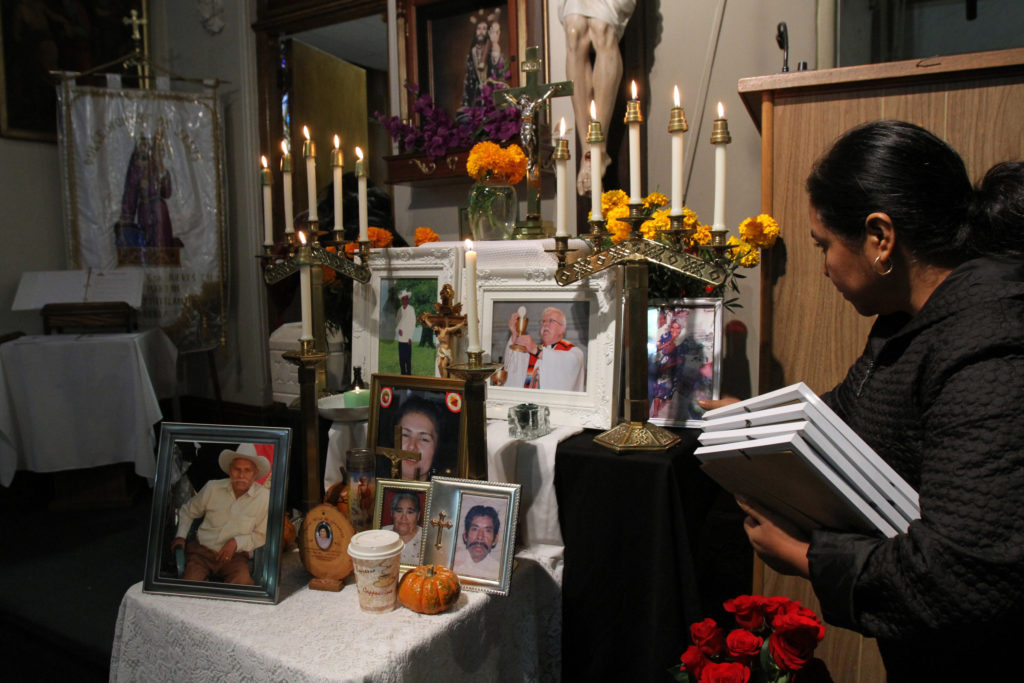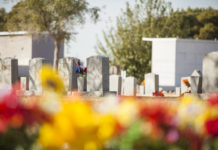

By Fr. Ernesto Reynoso, JCL
Parochial Administrator, Our Lady of Perpetual Help, Glendale
There is a growing interest around the world about the celebration of el Día de los Muertos, exemplified by two recent animation movies about this topic: “The Book of Life” and “Coco.” I believe that this fascination about the el Día de los Muertos celebration is the safest opportunity for people to talk freely about death without feeling vulnerable.
The central element of this celebration are the altars or los altares also known as ofrendas or offerings dedicated to persons who are no longer with us. These are personal and made of special belongings of the deceased person, food that the person enjoyed on earth, flowers, songs, candles, favorite saints and of course Our Lady and the Crucifix. However, some people mistakenly think that these altars are created for worshiping the deceased persons, which is not the case.
In indigenous beliefs, these altars on the Day of the Dead represent the living hope that their deceased loved ones, for at least one day of the year, will return to this earth from the afterworld, and share communion with their family members. People celebrate in cemeteries, churches and homes every year keeping the memory of their beloved ones alive. They do it with food, music, laughter, and the centrality of this gathering is that their beloved ones are not forgotten. The Day of the Dead is then a celebration of life in the afterworld.
In taking a Eucharistic approach to this celebration, I believe that the altars placed on the Day of the Dead have four Eucharistic elements. These are the altar, the presence, the communion and the afterlife. Catholics in a way, celebrate at daily Mass, with these same four elements.

The Altar
The altar, for us, is the Lord’s Cross and is also the table of the Lord, to which the People of God are invited. (See Catechism of the Catholic Church No.1182.) So, as people gather to make an altar for their beloved ones on the Day of the Dead to encounter their beloved ones, the altar for us is our sacred encounter with God at daily Mass.
The Presence
On the Day of the Dead, people wait for this day to remember their deceased family members. They patiently wait and are ready for their spiritual presence. For us at the sacrifice of the Mass, the memorial is the remembrance, the making alive, the true eternal presence of God in His body, blood, soul, and divinity of God in the paschal mystery. The one and true sacrifice of the Cross. As the Catechism of the Catholic Church points out, “It is the memorial of Christ, of his life, of his death, of his Resurrection, and of his intercession in the presence of the Father.” (CCC#1341) Thus it is the true presence of the Eucharist that God lives in our midst.
Communion
In a way, the celebration of the Day of the Dead is an imperfect communion of the visible world with the invisible world, the dead and the alive. It is a bridge that transcends time and space, it is the longing of eternal life, it is the hope that there is a better life waiting for us. However, for us, the true communion we have is in the Lord. It is through Him, with Him and in Him that we are united, visible and invisible. It is the triumph of the redeemed and the ultimate union of the creator with the created. Let’s quote the Catechism again, “Eucharist is the efficacious sign and sublime cause of that communion in the divine life and that unity of the People of God by which the Church is kept in being… and “by the Eucharistic celebration we already unite ourselves with the heavenly liturgy and anticipate eternal life, when God will be all in all.” (CCC 1325, 1326)
Afterlife
The centrality of the celebration of the Day of the Dead hopes for a better life after death. People believe that their beloved ones are, in a way, in a better place than the ones who are here on earth. They think of their family members as happy, joyful, free of infirmities, etc. Which at the end, points to our Catholic belief of the beatific vision in which we will see God as He is. For us, Jesus promised something better. He will dwell with us and will wipe every tear from our eyes: “There will be no more death or mourning or crying or pain, for the old order of things has passed away.” (Rev 21:4) This is the essence of our everlasting life. The invitation in the sharing of the eternal banquet of the Paschal Lamb at the new Jerusalem.
In sum, the altar, the presence, the communion and the afterlife, are the four Eucharistic elements that we can meditate from this celebration. Every time you admire an altar from the Day of the Dead, meditate on these key paschal elements. It is my hope that through this cultural celebration, you will become more Eucharistic.
Contact Catholic Cemeteries and Funeral Homes at (602) 267-3962 or at dopccfh.org.





